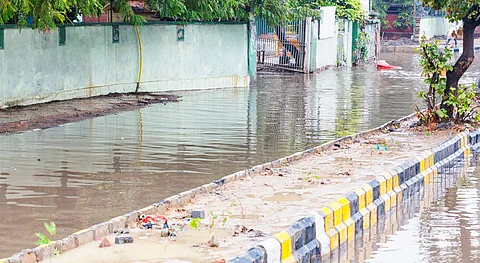

India needs to scale up investments by at least three times from Rs 425,300 crore to meet its climate targets, according to a new report by independent non-profit Climate Policy Initiative (CPI).
The mitigation sector is estimated to have attracted Rs 371,200 crore ($50 billion) on average per year in financial year 2021-22, a 20 per cent increase from 2019/20.
Adaptation-related sectors witnessed a nearly three-fold increase in investments in the same period, reaching Rs 1,09,200 crore ($15 billion) per year in 2021-22.
“India’s green finance landscape has made significant progress, but there is a long road ahead. This report highlights critical areas where action is needed to scale investments and bridge existing gaps,” Vivek Sen, director, CPI India, said in a statement.
The Indian government estimated that the country needs Rs 16,250,000 crore ($2.5 trillion) by 2030—amounting to Rs 1,100,000 crore annually ($170 billion)—to achieve its Nationally Determined Contributions (NDC). NDCs are national climate action plans by each country under the Paris Agreement to reduce greenhouse gas emissions to help meet the global goal of limiting temperature rise to 1.5°C and adapt to the impacts of climate change.
India’s cumulative adaptation-related investment needs are at least Rs 8,560,000 crore ($1 trillion)—or Rs 5,733,000 crore ($67 billion) per year from 2015 to 2030.
The CPI report, titled The Landscape of Green Finance in India, looked at both public and private sources of green finance in India. It also tracked domestic and international financial flows from their sources to end beneficiaries.
The report finds that around 83 per cent of India’s green finance for mitigation was sourced domestically. Of the 83 per cent of domestic mitigation finance, the private sector contributed 66 per cent.
International finance for mitigation increased to 17 per cent in 2021-22 from around 15 per cent in 2019-20. Of total international mitigation flows in 2021-22, contribution from private sources rose to 66 per cent up from 40 per cent in 2019-20. The remaining 34 per cent was traced back to public sources.
Among different sectors, clean energy attracted 47 per cent of the investment, with energy efficiency accounting 35 per cent, and clean transportation receiving 18 per cent of finances. All three sectors received the lion’s share of funding domestically.
Unlike mitigation, most of adaptation financing was raised through public means. Domestic sources, largely from central and state government budgets, accounted for 98 per cent of finance for 2021-22.
Funds for farm adaptation-related activities in agriculture from domestic private finance — private equity and venture capital funds — was negligible, less than 1 per cent.
Though international finance provides a small share, it has seen a growth of 19 per cent in 2021-22, compared to 2019/20. Of this, 92 per cent came from public international sources. The report warns that India’s adaptation investments are likely to increase with climate change.
Within the adaptation sector, disaster risk management received the most funding, representing 42 per cent of the flows. It also saw a ten-fold increase from 2019-20, primarily driven by increasing government budgetary expenditure.
This was followed by flood and cyclone mitigation and on-farm adaptation-related agricultural activities, receiving 32 per cent and 24 per cent of India’s adaptation funds.
Within on-farm adaptation-related agricultural activities, crop insurance got 58 per cent of the total finance. Public sources financed 99 per cent of on-farm adaptation activities.